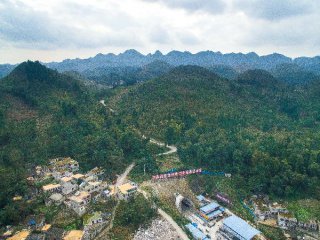
China has been the driving force behind the massive infrastructure projects in the Greater Mekong Sub-Region (GMS) during the past five years, according to a Vietnamese expert.
In an interview with Xinhua on Wednesday, Dr. Pham Sy Thanh, director of the Chinese Economic Studies Program under the Vietnam Economic Policy Research Institute, said that since 1992, when the Asian Development Bank (ADB) implemented a number of GMS development programs, China has made great efforts to connect the Chinese province of Yunnan and south China's Guangxi Zhuang Autonomous Region with the GMS countries.
Thanh said that realizing the demand for capital for infrastructure development and for the continued implementation of projects facilitated by the ADB in the last 10 years, China put forth the initiative of Asian Infrastructure Investment Bank (AIIB).
"The AIIB plays an active role in financing infrastructure projects in the GMS region since both the ADB and the World Bank could not meet the huge demands for capital in pursuing such projects," he said.
According to Thanh, when participating in regional infrastructure project led or funded by China, Vietnam should pay due attention to multiple aspects, such as balancing its interests with those of the Chinese and should have proper regional connections.
"The formation of Southeast Asia's infrastructure network in the Yunnan and Guangxi region would foster development of Myanmar, Laos, Thailand and Cambodia," Thanh said. Thanh said that Vietnam should have proper connections with the region's infrastructure network to fully tap their potential and avoid wasteful investment.
He said that Vietnam's major infrastructure projects such as the North-South expressway and seaports along coastal provinces will mainly serve domestic demand, adding that the government should also give priority to projects that would speed up intra-regional trade.
"Vietnam's seaports have great advantages, including Saigon Port which lies in international sea routes, but their management is poor, the cost is high and logistics system are insufficient," he said. Thanh said ASEAN and China's have developed stronger and closer economic bonds since the formation of the ASEAN-China Free Trade Area.
China is intensifying multilateral cooperative mechanisms with the ASEAN, including ASEAN +1, ASEAN +3, ASEAN Regional Forum and East Asia Summit, Thanh said. According to an official from the Vietnamese Embassy in China, Vietnam-China cooperation on economy, trade, and investment has played an outstanding role in the overall cooperative relations between the two countries.
In recent years, the bilateral cooperation on economy, trade and investment between China and Vietnam has attained considerable growth and Thanh predicted the two-way trade between Hanoi and Beijing would reach 60 billion U.S. dollars this year. The Vietnamese market consumes large amounts of Chinese oil and petroleum products, materials and accessories for garment and textile production, machines, equipment, fertilizers, chemicals and steel. Vietnam, on the other hand, exports crude oil, rubber, coal, seafood, fruits, vegetables, cashew nuts, vegetable oil, woodwork, plastic products, among others, to China in big quantities.
Besides increasingly improving trade and investment cooperation between Vietnam and China, ties between the two countries' border provinces are becoming closer and closer. The seven Vietnamese border provinces of Quang Ninh, Lang Son, Cao Bang, Ha Giang, Lao Cai, Lai Chau and Dien Bien and the two Chinese localities of Yunnan and Guangxi have actively cooperated on various fields, especially on the economy.
The Vietnamese and Chinese border localities have set up commercial areas, border areas and open economic zones to beef up their trade and investment relations. They have also strengthened construction and improvement of border infrastructure such as linking air, road and rail routes, and connecting water supply and electricity grids, contributing to better quality of life of local residents as well as closer trade and economic cooperation between Vietnam and China.
To date, China has nearly 1,180 investment projects with total registered capital of more than 8.4 billion U.S. dollars in Vietnam, ranking 9th among 105 countries and regions having investments in the country, according to the Foreign Investment Agency under the Vietnamese Ministry of Planning and Investment.






















Latest comments